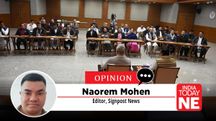Himanta Biswa Sarma’s action against madrassas is a civilisational war to protect Bharat
The burgeoning Muslim population in Assam provides a fertile ground for the expansion of Islamic activities, posing a serious danger to the national security of our country.
 Can we overlook the fact of systematic brainwashing of Muslims that happens through educational institutions? Asks Ankita Dutta
Can we overlook the fact of systematic brainwashing of Muslims that happens through educational institutions? Asks Ankita DuttaAssam Chief Minister Himanta Biswa Sarma recently said that Assam was becoming a hotbed for Islamic fundamentalism, with the Government having busted several jihadi modules associated with Al-Qaeda affiliated terror outfits in Bangladesh in the past few months. Several incriminating facts and evidence of madrassas having deep links to the Ansarullah Bangla Team (ABT) operating in different parts of Assam, especially in the Barak Valley and the border districts of Lower Assam, have already been unearthed by the Assam Police during their investigation.
It has always been suspected that the burgeoning Muslim population in Assam provides a fertile ground for the expansion of Islamic activities, posing a serious threat to the national security of our country. Both in Lower Assam and the Barak Valley, there is a significant presence of Bangladeshi maulvis and imams who arrive here on tourist visas for “religious preaching”. But, many a time, these maulvis have openly violated visa norms trying to indoctrinate the Muslim youths of Assam. Although many such maulvis and imams have been barred from entering the state on the ground of repeated violation of visa norms and regulations, the situation on the ground remains very serious.
Intelligence reports have, time and again, pointed suspicious fingers at the Jamaat-e-Islami and its patron, the Inter-Services Intelligence (ISI) of Pakistan. Both have been actively using madrassas— proliferating along the Indo-Bangladesh border in Lower Assam and North Bengal along the strategically located Siliguri Corridor—to infiltrate migrants into India so that those could be used as spies. But, as of today, matters have become more complicated especially because of the presence of terrorist organisations like the ABT, which are inspired by the anti-human, genocidal Islamic belief of eliminating kuffrs/kafirs (non-believers) who do not follow Islam.
What is more dangerous is that the organisation is inspired by the Islamic teachings of imams such as Ayman-al-Awlaki, and thereby targets independent writers, scholars and intellectuals and bloggers, whom they consider as a “direct threat” to their ideology.
The problem in Assam has assumed more complex dimensions. A peculiar characteristic trait of the ABT is that it begins its Islamic activities on a completely silent note, targeting poor, illiterate Muslim youth. The plan to execute their religious agenda in the long-term. After setting up a base in any area, it continues its activities clandestinely for several years until it becomes viable and strong enough to strike terror among the local populace.
The cyber space has, of late, emerged as an easy medium for these terror organisations to attract the youth. These young men and women are then trained in the handling of arms and weapons, explosives and making use of untraceable, sophisticated routes of escape after carrying out criminal activities in non-Muslim areas. The madrassas, no doubt, serve as a hotbed for the flourishing of these activities, mostly with the connivance of the local Muslim population of the area.
The Government of Assam has adopted a pro-active stance to tackle this menace by destroying several such madrassas built on illegally occupied lands. It is a fact that any act of violence or defiance of law is committed by Muslims in the name of outraged feelings. The non-compliance of a particular order of the state taking recourse in their Islamic precepts and principles was best visible in the shameful behaviour of the Tablighis following the Nizamuddin Markaz incident in Delhi in April 2020. It was perhaps the best manifestation of a sick, illogical mindset that still harbours the continuation and consolidation of the Do Qaumi Nazariya of the Muslim politics from pre-partition era. It is the idea that propagates that Hindus and Muslims are two different and separate nations existing within India.
This has been the guiding force of the Islamist political imagination since the very beginning, ultimately culminating in the Partition of India in 1947. This separatist imagination has not died down despite the fact that almost one-third of India’s geographical area was cut off from its cultural and civilisational roots and converted into a theocratic Islamic state at the time of the Partition. But, the biggest irony has been the proclamation made from time to time by the fountainhead of the movement that demanded a separate state of Pakistan—the Aligarh Muslim University (AMU)—claiming that it is a firm believer of secularism and that Muslims who stayed back in India after the Partition did it out of their own choice.
Contrarily, however, it happened largely because of two key factors – the impracticability of a wholesale migration of all Muslims to Pakistan, and also because of pursuing their long-term goal of playing the victim card and as well as that of a nationalist at the same time by choosing to remain in India. This was a well-crafted strategy by the Muslim elites who lived in India at that time – a covert operation of weakening the Indian state from inside and finally converting it into a Dar-ul-Islam. The history of leaders like Sadullah and Moinul Haque Choudhury in the context of Assam aptly proves this point.
In the guise of being politically correct, can we still overlook or ignore the fact of systematic brainwashing of Muslims that happens through their educational institutions? For instance, the controversy that erupted over the portrait of Muhammad Ali Jinnah at AMU or the shouting of slogans like Jinnah-wali Azadi during the anti-CAA protests at Shaheen Bagh in early 2020, are enough to bring to light the step-by-step indoctrination of Muslims in the “minority” educational institutions of our country.
This is nothing but a strategic and planned injection of pro-Pakistan and anti-India feelings in the minds of young Muslim students in madrassas by Islamic clerics, and in universities by a faculty that is closely aligned with the Communist ideology in association with the Islamists. The so-called “spontaneous” protests that began in New Delhi’s Jamia Milia Islamia immediately after the enactment of the CAA, 2019 was the outburst of frustration that followed the abrogation of Article 370 in Jammu and Kashmir, criminalisation of instant Triple Talaq, and finally the Ram Mandir judgement.
The different imageries that were used in these well-organised protests throughout the country were an explicit manifestation of this frustration. Be it the Free Kashmir posters, Ma Kali wearing hijab, bindi-adorning women shown in burqa and standing over broken Swastika, many other such incendiary symbols and slogans came to be used freely, all in the name of freedom of speech and expression! Both AMU and Jamia Milia Islamia had assumed a leadership role in these protests.
Slogans like Hindutva ki Kabr Khudegi, AMU ki Dharti Par, and Khilafat 2.0, the outrageous speech of JNU “Research Scholar” Sharjeel Imam provoking Muslims to cut off North-East India, specifically Assam, from the rest of India, or a leading journalist lecturing on an “Ideal Society” and “Inclusive Protests”, all these took place in the AMU campus. On a similar vein, Jamia Milia Islamia served as the primary nerve-centre of the anti-CAA protests before the drama shifted to the infamous Shaheen Bagh.
Post the anti-CAA protests in the country, the realities were gradually exposed with open death threats being issued by using smileys such as brass hijab in the AMU campus. If such is the state of Central Universities like the AMU and Jamia in our country, which are supposed to be “secular” institutions, it is not difficult to fathom the pathetic state of madrassas where the clearly stated objective is religious education. No wonder that the imams and maulvis dare to openly defy the orders of state governments and declare the National Anthem of India as going against the basic tenets of Islam!
It was especially after the Ram Mandir judgement that collective hate and angst came to be expressed against the Supreme Court’s verdict by prominent Muslim individuals and groups. Maulanas associated with the All-India Muslim Personal Law Board (AIMPLB), Maulana Sajid Rashidi of the All-India Imam Association (AIIA), Munnawar Rana and countless others had shown their true colours. All these developments are important to be revisited to understand their chronological significance in the body-politic of the Indian nation-state with respect to the recent steps undertaken by the Government of Assam against madrassas and their Islamic clerics.
Islamic radicalisation is a wake-up call for states like Assam, West Bengal, and Kerala regarding the future course of challenges that they are going to face, sooner or later. What needs to be clearly understood by all the non-Muslim communities is that the unfinished agenda of India’s Partition in 1947 is not just limited to Kashmir alone. The Do Qaumi Nazariya is alive and thriving even today. Only their tactics have changed, with new strategies being continuously adopted to enforce it upon the people of India. It is a lethal combination of a naked show of muscle power on the streets and intellectual support from universities and educational institutions, occupied by the crème-da-la-crème of our society.
The far advanced modes of technology and communication, aided by the deep penetration of social media, have enabled the reach of this toxic ideology into a much larger and wider arena. But what is more important is that Assam Chief Minister Himanta Biswa Sarma has dared to call a spade a spade, which is actually the starting point for challenging and defeating this devilish tendency – a clear and present danger to the civilisational identity of Bharat. Appeasement politics bred its own share of problems in pre-Independent India. After all, the system of separate electorates was the root cause behind the creation of Pakistan, if viewed in retrospect. This is a question worth-asking by every rational mind.
The writer is an Assistant Professor at the Indus Institute of Special Studies, Indus University, Ahmedabad
Copyright©2025 Living Media India Limited. For reprint rights: Syndications Today









